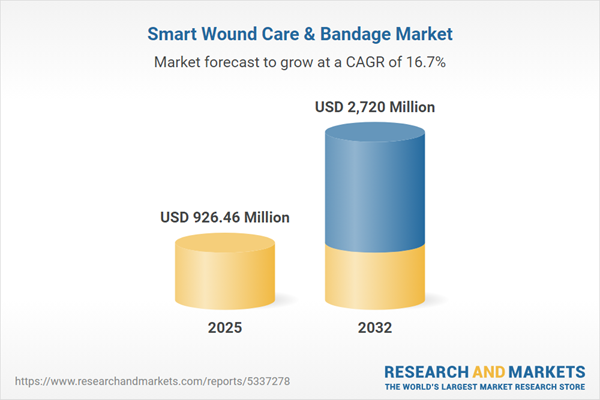Speak directly to the analyst to clarify any post sales queries you may have.
The global smart wound care and bandage market is rapidly transforming, integrating advanced materials and digital health technologies to deliver adaptive and personalized wound management. Industry stakeholders face a shifting landscape as innovation, regulatory changes, and evolving clinical needs converge to redefine product development and strategic priorities.
Market Snapshot: Growth, Dynamics, and Opportunities
The Smart Wound Care & Bandage Market grew from USD 792.39 million in 2024 to USD 926.46 million in 2025. It is expected to continue growing at a CAGR of 16.71%, reaching USD 2.72 billion by 2032. This robust expansion underscores increasing adoption driven by digital integration, a heightened focus on outcomes, and the demand for advanced, responsive wound care solutions. Senior executives should anticipate rising opportunities for product innovation and cross-sector investment as the market matures.
Scope & Segmentation of the Smart Wound Care & Bandage Market
This report examines the scope of the smart wound care and bandage industry, covering a comprehensive segmentation of products, technologies, applications, and regional dynamics to support strategic planning and operational execution.
- Product Types: Advanced dressings (alginate, film and gauze, foam, hydrocolloid, hydrogel), NPWT systems (portable, stationary), and traditional dressings (cotton gauze, non-woven fabric).
- Technologies: Biosensing (oxygen, pH, temperature sensors); drug delivery (hydrogel-based, microneedle-based, nanoparticle-based); and stimuli responsive modes (electroactive, photoresponsive, thermoresponsive dressings).
- Wound Types: Acute wounds (including burn wounds, surgical incisions, traumatic injuries) and chronic wounds (diabetic foot ulcers, pressure ulcers, venous leg ulcers).
- Distribution Channels: Clinics, hospitals, home healthcare providers, retail pharmacies, online platforms.
- End Users: Clinical environments, home healthcare settings, and direct patient care.
- Regions: Americas (United States, Canada, Mexico, Latin America markets), Europe, Middle East & Africa (regional leaders and emerging markets), and Asia-Pacific countries (including China, India, Japan, and more).
Key Takeaways for Decision-Makers
- Digital health integration and biosensor-enabled dressings allow real-time wound monitoring and tailored therapy, supporting remote care and reducing readmissions.
- Electroactive and photoresponsive dressings now enable adaptive, responsive treatments, enhancing therapeutic precision and setting new standards in patient outcomes.
- Recent regulatory updates accelerate device approvals but require robust safety evidence, aligning innovation with compliance mandates across global regions.
- Manufacturers are optimizing supply chains by investing in local production, joint ventures, and nearshoring to manage input costs and align with changing tariff structures.
- Cross-disciplinary collaboration is increasing, with material scientists, clinicians, and digital health partners driving pipeline advances and clinical adoption.
- Segmentation highlights the growing demand for targeted solutions tailored to chronic and acute wounds, distributed across hospital, clinic, and home-based care.
Tariff Impact: Strategic Sourcing and Manufacturing Shifts
The introduction of new United States tariffs for 2025 is prompting a thorough reevaluation of sourcing strategies throughout the smart wound care value chain. Increased costs for raw materials and sensors are driving companies to diversify suppliers, consider nearshoring, and invest in local manufacturing capabilities. This shift favors market players with agile, vertically integrated supply chains and the flexibility to adjust to new regulatory landscapes. Collaborative production agreements and transparent pricing will become essential to maintaining both competitive edge and access to critical biosensing innovations.
Methodology & Data Sources
This report employs a mixed-method approach, combining in-depth interviews with clinicians and product developers, and systematic secondary research from regulatory filings, peer-reviewed journals, and industry whitepapers. Quantitative analysis includes patent landscape reviews and scenario analysis, while data triangulation validates market trends and supply chain developments.
Why This Report Matters
- Supports executive strategy with actionable segment-level insights across products, regions, and emerging care models.
- Enables risk and opportunity assessment in light of evolving technology, regulation, and supply chain factors.
- Equips product and procurement leaders with a forward-looking view of innovation and partnership trends shaping market direction.
Conclusion
The smart wound care and bandage sector is evolving, driven by innovation in materials and digital health integration. Success will depend on adaptive strategies, resilient supply chains, and a clear focus on patient-centric technologies as market complexity increases.
Additional Product Information:
- Purchase of this report includes 1 year online access with quarterly updates.
- This report can be updated on request. Please contact our Customer Experience team using the Ask a Question widget on our website.
Table of Contents
3. Executive Summary
4. Market Overview
7. Cumulative Impact of Artificial Intelligence 2025
List of Figures
Samples

LOADING...
Companies Mentioned
The key companies profiled in this Smart Wound Care & Bandage market report include:- Smith & Nephew plc
- 3M Company
- Mölnlycke Health Care AB
- Convatec Group plc
- Johnson & Johnson
- B. Braun Melsungen AG
- Coloplast A/S
- Urgo Medical SA
- Integra LifeSciences Holdings Corporation
- Essity Aktiebolag
Table Information
| Report Attribute | Details |
|---|---|
| No. of Pages | 180 |
| Published | October 2025 |
| Forecast Period | 2025 - 2032 |
| Estimated Market Value ( USD | $ 926.46 Million |
| Forecasted Market Value ( USD | $ 2720 Million |
| Compound Annual Growth Rate | 16.7% |
| Regions Covered | Global |
| No. of Companies Mentioned | 11 |









